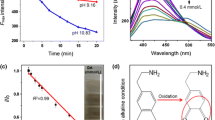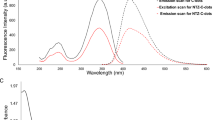Abstract
Monitoring of dihydropyridine drugs, such as nifedipine (NIF), has attracted considerable attention owing to the side effects arising from the consumption of such drugs. Herein, a highly sensitive and facile fluorescence-sensing platform based on a high-quantum-yield sulfur quantum dot (SQDs) probe for NIF detection is proposed. Based on the principle of the inner filter effect, the rapid detection of NIF with high sensitivity is successfully realized on the basis of the change in the fluorescence signal due to the quenching effect of NIF on SQDs. The results show a good linear relationship between the NIF concentration and fluorescence intensity within the range of 5–150 μmol/L, with a low detection limit of 1.63 μmol/L (S/N = 3). Moreover, because no surface modification or establishment of any coupling between the receptor and the fluorophore is necessary, this approach provides considerable flexibility and simplicity for the construction of a fluorescence sensor and substantially reduces the detection time. A systematic investigation was conducted to verify the applicability of this method for the analysis of pharmaceutical components in NIF tablets. This study not only promotes the design and development of a fluorescence analysis platform for NIF detection, but also facilitates the fabrication of novel SQD-based fluorescence-sensing systems for the molecular detection of drugs.
Graphical abstract

Proposal for a facile nifedipine assay method based on the inner filter effect of nifedipine to high-quantum-yield sulfur quantum dots, and realizing nifedipine detection in tablets and human urine samples.




Similar content being viewed by others
References
Tozatto E, Benzi JRL, Rocha A, Coelho EB, Lanchote VL. Nifedipine does not alter the pharmacokinetics of venlafaxine enantiomers in healthy subjects phenotyped for CYP2D6, CYP2C19, and CYP3A. J Clin Pharmacol. 2021;61(3):319–27.
Cheng S, McKenna GB. Isothermal crystallization and time–temperature transformation of amorphous nifedipine: a case of polymorphism formation and conversion. Mol Pharm. 2021;18(7):2786–802.
Hashemi M, Abbasnejad M, Moghimi A, Esmaeili-Mahani S, Zamyad M, Heydari A. Enhancing the anticonvulsant effects of nifedipine in rats through encapsulation with water-soluble β-cyclodextrin polymer. Pharm Chem. 2022;55(10):1023–7.
Castelino R, Buch S, Laxmana A. Nifedipine-induced gingival enlargement: a case report with review. Curr Med Issues. 2021;19(1):54–7.
Özaltın N, Nemutlu E, Yardımcı C, Süslü İ. Application of micellar electrokinetic capillary chromatography for the determination of nifedipine and its degradation product in pharmaceutical preparations. Anal Lett. 2003;36(2):371–87.
Fattore L, Stablein M, Bredfeldt G, Semla T, Moran M, Doherty-Greenberg JM. Gingival hyperplasia: a side effect of nifedipine and diltiazem. Special Care Dentistry. 1991;11(3):107–9.
Mascher H, Vergin H. HPLC-determination of nifedipine in plasma on normal phase. Chromatographia. 1988;25(10):919–22.
Jalili R, Amjadi M. Surface molecular imprinting on silane-functionalized carbon dots for selective recognition of nifedipine. RSC Adv. 2015;5(90):74084–90.
Abed SS. Cloud-point extraction and spectrophotometric determination of clonazepam in pharmaceutical dosage forms. Syst Rev Pharm. 2020;11(7):125–30.
Alsaeedi IM, Abed SS, Muhamad YH. Spectrophotometric determination of nifedipine in pharmaceutical tablets using batch and flow injection method via diazotization coupling reaction. Indian J Pub Health Resear Develop. 2019;10(10):975–82.
Al-Ghannam S, Al-Olyan A. Spectrofluorometric determination of nicardipine, nifedipine and isradipine in pharmaceutical preparations and biological fluids. Open Chem. 2008;6(2):222–8.
Arumugam B, Muthukutty B, Chen SM, Subramanian BT, Biju VMN, Ramaraj SK. Electrochemical reduction of Procardia drug with aid of silver phosphate/strontium phosphate nanoparticles (AgP/SrP NPs) modified glassy carbon electrode. Microchem J. 2020;159:105565.
Chen W, Luo H, Liu X, Foley JW, Song X. Broadly applicable strategy for the fluorescence based detection and differentiation of glutathione and cysteine/homocysteine: demonstration in vitro and in vivo. Anal Chem. 2016;88(7):3638–46.
Deng J, Xu J, Ouyang M, Zou Z, Lei Y, Li J, et al. Target-triggered hairpin-free chain-branching growth of DNA dendrimers for contrast-enhanced imaging in living cells by avoiding signal dispersion. Chin Chem Lett. 2022;33(2):773–7.
Liang YQ, Wu XY, Zeng JY, Wu YN, Lai JP, Sun H. A novel fluorescence ratio probe based on dual-emission carbon dots for highly selective and sensitive detection of chlortetracycline and cell imaging. Anal Bioanal Chem. 2022;414(9):3043–55.
Xu Z, Zhang C, Yu X, Zheng H, Xu L. Microwave-assisted solid-phase synthesis of nitrogen-doping carbon dot with good solvent compatibility and its sensing of sunitinib. Anal Bioanal Chem. 2021;413(25):6435–47.
Shen L, Wang H, Liu S, Bai Z, Zhang S, Zhang X, et al. Assembling of sulfur quantum dots in fission of sublimed sulfur. J Am Chem Soc. 2018;140(25):7878–84.
Wang H, Wang Z, Xiong Y, Kershaw SV, Li T, Wang Y, et al. Hydrogen peroxide assisted synthesis of highly luminescent sulfur quantum dots. Angew Chem Int Ed. 2019;58(21):7040–4.
Wang Z, Zhang C, Wang H, Xiong Y, Yang X, Shi Y-e, et al. Two-step oxidation synthesis of sulfur with a red aggregation-induced emission. Angew Chem Int Ed. 2020;59(25):9997–10002.
Xiao L, Du Q, Huang Y, Wang L, Cheng S, Wang Z, et al. Rapid synthesis of sulfur nanodots by one-step hydrothermal reaction for luminescence-based applications. ACS Appl Nano Mater. 2019;2(10):6622–8.
Sheng Y-L, Huang Z-N, Zhong Q, Deng H-H, Lai M-C, Yang Y, et al. Size-focusing results in highly photoluminescent sulfur quantum dots with steadfast emission wavelength. Nanoscale. 2021;13(4):2519–26.
Li S, Chen D, Zheng F, Zhou H, Jiang S, Wu Y. Water-soluble and lowly toxic sulphur quantum dots. Adv Funct Mater. 2014;24(45):7133–8.
Gongxi Q, Liu L, Hao X, Zheng J, Liu W, Zhang C, et al. Signal transduction from small particles: Sulfur nanodots featuring mercury sensing, cell entry mechanism and in vitro tracking performance. Chem Eng J. 2019;382:122907.
Duan Y, Tan J, Huang Z, Deng Q, Liu S, Wang G, et al. Facile synthesis of carboxymethyl cellulose sulfur quantum dots for live cell imaging and sensitive detection of Cr(VI) and ascorbic acid. Carbohydr Polym. 2020;249:116882.
Wang S, Bao X, Gao B, Li M. A novel sulfur quantum dot for the detection of cobalt ions and norfloxacin as a fluorescent "switch". Dalton Trans. 2019;48(23):8288–96.
Li G, Fu H, Chen X, Gong P, Chen G, Xia L, et al. Facile and sensitive fluorescence sensing of alkaline phosphatase activity with photoluminescent carbon dots based on inner filter effect. Anal Chem. 2016;88(5):2720–6.
Zheng M, Xie Z, Qu D, Li D, Du P, Jing X, et al. On–off–on fluorescent carbon dot nanosensor for recognition of chromium(vi) and ascorbic acid based on the inner filter effect. ACS Appl Mater Interfaces. 2013;5(24):13242–7.
Deng H-H, Peng H, Huang K-Y, He S, Yuan Q-F, Lin Z, et al. Self-referenced ratiometric detection of sulfatase activity with dual-emissive urease-encapsulated gold nanoclusters. ACS Sensors. 2019;4(2):344–52.
Puchalski MM, Morra MJ, von Wandruszka R. Assessment of inner filter effect corrections in fluorimetry. Fresenius J Anal Chem. 1991;340(6):341–4.
Peng J, Zhuge W, Huang Y, Zhang C, Huang W. UV-light photoelectrochemical sensor based on the copper tetraamino-phthalocyanine-modified ITO electrode for the detection of nifedipine in drugs and human serum. Bull Korean Chem Soc. 2019;40(3):214–9.
Rahman N, Hoda MN. Spectrophotometric method for the determination of nifedipine with 4-(methylamino)phenol and potassium dichromate. Il Farmaco. 2002;57(6):435–41.
Jalili R, Amjadi M. Surface molecular imprinting on silane-functionalized carbon dots for selective recognition of nifedipine. RSC Adv. 2015;5(90):74084–90.
Aderibigbe SA, Adegoke OA, Idowu OS. A new colorimetric method for the determination of nifedipine tablets by derivatization using 4-carboxyl-2,6-dinitrobenzene diazonium ion. Int J Ind Chem. 2012;3(1):5.
Acknowledgements
This study was supported by the National Natural Science Foundation of China (21874020), the National Science Foundation for Distinguished Young Scholars of Fujian Province (2020J06019), Program for Fujian Youth Talent Support Project (2019B016), and Program for Fujian Top-Notch Innovative Personnel (Fujian Commission Talent [2018] no. 5).
Author information
Authors and Affiliations
Corresponding authors
Ethics declarations
Conflict of interest
The authors declare no competing interests.
Urine samples in this study were obtained from one healthy adult volunteer. This study was approved by the Institutional Ethics Committee of Fujian Medical University, and experiments with real samples were performed in accordance with ethical standards. Informed consent was obtained from the participant in the study.
Additional information
Publisher’s note
Springer Nature remains neutral with regard to jurisdictional claims in published maps and institutional affiliations.
Supplementary information
ESM 1
(DOCX 586 kb)
Rights and permissions
Springer Nature or its licensor holds exclusive rights to this article under a publishing agreement with the author(s) or other rightsholder(s); author self-archiving of the accepted manuscript version of this article is solely governed by the terms of such publishing agreement and applicable law.
About this article
Cite this article
Sheng, Y., Huang, Z., Chen, Y. et al. Facile high-quantum-yield sulfur-quantum-dot-based photoluminescent probe for nifedipine detection. Anal Bioanal Chem 414, 7675–7681 (2022). https://doi.org/10.1007/s00216-022-04297-9
Received:
Revised:
Accepted:
Published:
Issue Date:
DOI: https://doi.org/10.1007/s00216-022-04297-9




